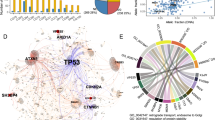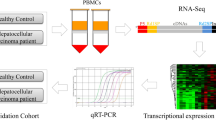Abstract
There is an urgent need to identify biomarkers for hepatocellular carcinoma due to limited treatment options and the poor prognosis of this common lethal disease. Whole-transcriptome shotgun sequencing (RNA-Seq) provides new possibilities for biomarker identification. We sequenced ∼250 million pair-end reads from a pair of adjacent normal and tumor liver samples. With the aid of bioinformatics tools, we determined the transcriptome landscape and sought novel biomarkers by further empirical validations in 55 pairs of adjacent normal and tumor liver samples with various viral statuses such as HBV(+), HCV(+) and HBV(−)HCV(−). We identified a novel gene with coding regions, termed DUNQU1, which has a tissue-specific expression pattern in tumor liver samples of HCV(+) and HBV(−)HCV(−) hepatocellular carcinomas. Overexpression of DUNQU1 in Huh7 cell lines enhances the ability to form colonies in soft agar. Also, we identified three novel differentially-expressed protein-coding genes (ALG1L, SERPINA11 and TMEM82) that lack documented expression profiles in liver cancer and showed that the level of SREPINA11 is correlated with pathology stages. Moreover, we showed that the alternative splicing event of FGFR2 is associated with virus infection, tumor size, cirrhosis and tumor recurrence. The findings indicate that these new markers of hepatocellular carcinoma may be of value in improving prognosis and could have potential as new targets for developing new treatment options.
This is a preview of subscription content, access via your institution
Access options
Subscribe to this journal
Receive 50 print issues and online access
$259.00 per year
only $5.18 per issue
Buy this article
- Purchase on Springer Link
- Instant access to full article PDF
Prices may be subject to local taxes which are calculated during checkout




Similar content being viewed by others
Abbreviations
- HCC:
-
hepatocellular carcinoma
- RNA-Seq:
-
whole-transcriptome shotgun sequencing
- HCV:
-
hepatitis C virus
- HBV:
-
hepatitis B virus
- FPKM:
-
fragments per kilobase of transcript per million mapped reads
- DNA:
-
deoxyribonucleic acid
- GTF:
-
Gene Transfer Format
- AS:
-
alternative splicing
- CA:
-
cassette exon
- AA:
-
alternative acceptor
- AD:
-
alternative donor
- IR:
-
intron retention
- PCR:
-
polymerase chain reaction
- DE genes:
-
differentially expressed protein-coding genes
- TSS:
-
transcription start side
- PTC:
-
premature termination codon
- IHC:
-
immunohistochemistry
- RT-qPCR:
-
reverse transcription quantitative real time polymerase chain reaction.
References
Ozsolak F, Milos PM . RNA sequencing: advances, challenges and opportunities. Nat Rev Genet 2011; 12: 87–98.
Sultan M, Schulz MH, Richard H, Magen A, Klingenhoff A, Scherf M et al. A global view of gene activity and alternative splicing by deep sequencing of the human transcriptome. Science 2008; 321: 956–960.
Morin R, Bainbridge M, Fejes A, Hirst M, Krzywinski M, Pugh T et al. Profiling the HeLa S3 transcriptome using randomly primed cDNA and massively short-read sequencing. Biotechniques 2008; 45: 81–94.
Lander ES . Initial impact of the sequencing of the human genome. Nature 2011; 470: 187–197.
Clark MB, Amaral PP, Schlesinger FJ, Dinger ME, Taft RJ, Rinn JL et al. The reality of pervasive transcription. PLoS Biol 2011; 9: e1000625 discussion e1001102.
Pickrell JK, Pai AA, Gilad Y, Pritchard JK . Noisy splicing drives mRNA isoform diversity in human cells. PLoS Genet 2010; 6: e1001236.
Garber M, Grabherr MG, Guttman M, Trapnell C . Computational methods for transcriptome annotation and quantification using RNA-seq. Nat Methods 2011; 8: 469–477.
Barrett T, Troup DB, Wilhite SE, Ledoux P, Evangelista C, Kim IF et al. NCBI GEO: archive for functional genomics data sets—10 years on. Nucleic Acids Res 2011; 39: D1005–D1010.
Kapushesky M, Adamusiak T, Burdett T, Culhane A, Farne A, Filippov A et al. Gene Expression Atlas update—a value-added database of microarray and sequencing-based functional genomics experiments. Nucleic Acids Res 2012; 40: D1077–D1081.
Parkinson H, Sarkans U, Kolesnikov N, Abeygunawardena N, Burdett T, Dylag M et al. ArrayExpress update—an archive of microarray and high-throughput sequencing-based functional genomics experiments. Nucleic Acids Res 2011; 39: D1002–D1004.
Rhodes DR, Kalyana-Sundaram S, Mahavisno V, Varambally R, Yu J, Briggs BB et al. Oncomine 3.0: genes, pathways, and networks in a collection of 18,000 cancer gene expression profiles. Neoplasia 2007; 9: 166–180.
Petretti T, Kemmner W, Schulze B, Schlag PM . Altered mRNA expression of glycosyltransferases in human colorectal carcinomas and liver metastases. Gut 2000; 46: 359–366.
Parris TZ, Danielsson A, Nemes S, Kovács A, Delle U, Fallenius G et al. Clinical implications of gene dosage and gene expression patterns in diploid breast carcinoma. Clin Cancer Res 2010; 16: 3860–3874.
Zdobnov EM, Apweiler R . InterProScan—an integration platform for the signature-recognition methods in InterPro. Bioinformatics 2001; 17: 847–848.
Hertervig E, Nilsson A, Nyberg L, Duan RD . Alkaline sphingomyelinase activity is decreased in human colorectal carcinoma. Cancer 1997; 79: 448–453.
Cheng Y, Wu J, Hertervig E, Lindgren S, Duan D, Nilsson A et al. Identification of aberrant forms of alkaline sphingomyelinase (NPP7) associated with human liver tumorigenesis. Br J Cancer 2007; 97: 1441–1448.
Eichler EE, Zimmerman AW . A hot spot of genetic instability in autism. N Engl J Med 2008; 358: 737–739.
Bochukova EG, Huang N, Keogh J, Henning E, Purmann C, Blaszczyk K et al. Large, rare chromosomal deletions associated with severe early-onset obesity. Nature 2010; 463: 666–670.
Myers RM, Stamatoyannopoulos J, Snyder M, Dunham I, Hardison RC, Bernstein BE et al. A user's guide to the encyclopedia of DNA elements (ENCODE). PLoS Biol 2011; 9: e1001046.
Wu J, Akerman M, Sun S, McCombie WR, Krainer AR, Zhang MQ . SpliceTrap: a method to quantify alternative splicing under single cellular conditions. Bioinformatics 2011; 27: 3010–3016.
Kamburov A, Pentchev K, Galicka H, Wierling C, Lehrach H, Herwig R . ConsensusPathDB: toward a more complete picture of cell biology. Nucleic Acids Res 2011; 39: D712–D717.
Takai H, Wang RC, Takai KK, Yang H, de Lange T . Tel2 regulates the stability of PI3K-related protein kinases. Cell 2007; 131: 1248–1259.
Grosso AR, Martins S, Carmo-Fonseca M . The emerging role of splicing factors in cancer. EMBO Rep 2008; 9: 1087–1093.
David CJ, Manley JL . Alternative pre-mRNA splicing regulation in cancer: pathways and programs unhinged. Genes Dev 2010; 24: 2343–2364.
Warzecha CC, Sato TK, Nabet B, Hogenesch JB, Carstens RP . ESRP1 and ESRP2 are epithelial cell-type-specific regulators of FGFR2 splicing. Mol Cell 2009; 33: 591–601.
Amann T, Bataille F, Spruss T, Dettmer K, Wild P, Liedtke C et al. Reduced expression of fibroblast growth factor receptor 2IIIb in hepatocellular carcinoma induces a more aggressive growth. Am J Pathol 2010; 176: 1433–1442.
Shapiro IM, Cheng AW, Flytzanis NC, Balsamo M, Condeelis JS, Oktay MH et al. An EMT-driven alternative splicing program occurs in human breast cancer and modulates cellular phenotype. PLoS Genet 2011; 7: e1002218.
Kleino I, Ortiz RM, Huovila AP . ADAM15 gene structure and differential alternative exon use in human tissues. BMC Mol Biol 2007; 8: 90.
Ortiz RM, Karkkainen I, Huovila AP . Aberrant alternative exon use and increased copy number of human metalloprotease-disintegrin ADAM15 gene in breast cancer cells. Genes Chromosomes Cancer 2004; 41: 366–378.
Mochizuki S, Okada Y . ADAMs in cancer cell proliferation and progression. Cancer Sci 2007; 98: 621–628.
Lin R, Maeda S, Liu C, Karin M, Edgington TS . A large noncoding RNA is a marker for murine hepatocellular carcinomas and a spectrum of human carcinomas. Oncogene 2007; 26: 851–858.
Panzitt K, Tschernatsch MM, Guelly C, Moustafa T, Stradner M, Strohmaier HM et al. Characterization of HULC, a novel gene with striking up-regulation in hepatocellular carcinoma, as noncoding RNA. Gastroenterology 2007; 132: 330–342.
Gutschner T, Diederichs S . The hallmarks of cancer: a long non-coding RNA point of view. RNA Biol 2012; 9: 703–719.
Ecker JR, Bickmore WA, Barroso I, Pritchard JK, Gilad Y, Segal E . Genomics: ENCODE explained. Nature 2012; 489: 52–55.
Hua Y, Sahashi K, Rigo F, Hung G, Horev G, Bennett CF et al. Peripheral SMN restoration is essential for long-term rescue of a severe spinal muscular atrophy mouse model. Nature 2011; 478: 123–126.
Turner N, Grose R . Fibroblast growth factor signalling: from development to cancer. Nat Rev Cancer 2010; 10: 116–129.
Huijts PE, van Dongen M, de Goeij MC, van Moolenbroek AJ, Blanken F, Vreeswijk MP et al. Allele-specific regulation of FGFR2 expression is cell type-dependent and may increase breast cancer risk through a paracrine stimulus involving FGF10. Breast cancer research: BCR 2011; 13: R72.
Somarelli JA, Schaeffer D, Bosma R, Bonano VI, Sohn JW, Kemeny G et al. Fluorescence-based alternative splicing reporters for the study of epithelial plasticity in vivo. Rna 2013; 19: 116–127.
Huang Q, Lin B, Liu H, Ma X, Mo F, Yu W et al. RNA-Seq analyses generate comprehensive transcriptomic landscape and reveal complex transcript patterns in hepatocellular carcinoma. PLoS One 2011; 6: e26168.
Toung JM, Morley M, Li M, Cheung VG . RNA-sequence analysis of human B-cells. Genome Res 2011; 21: 991–998.
Trapnell C, Pachter L, Salzberg SL . TopHat: discovering splice junctions with RNA-Seq. Bioinformatics 2009; 25: 1105–1111.
Wang K, Singh D, Zeng Z, Coleman SJ, Huang Y, Savich GL et al. MapSplice: accurate mapping of RNA-seq reads for splice junction discovery. Nucleic Acids Res 2010; 38: e178.
Trapnell C, Williams BA, Pertea G, Mortazavi A, Kwan G, van Baren MJ et al. Transcript assembly and quantification by RNA-Seq reveals unannotated transcripts and isoform switching during cell differentiation. Nat Biotechnol 2010; 28: 511–515.
Flicek P, Amode MR, Barrell D, Beal K, Brent S, Chen Y et al. Ensembl 2011. Nucleic Acids Res 2011; 39: D800–D806.
Acknowledgements
We thank the Taiwan Liver Cancer Network for providing the liver tumor tissue samples and related clinical data (all are anonymous) for this work. This network currently includes five major medical centers in Taiwan (National Taiwan University Hospital, Chang-Gung Memorial Hospital-Linko, Veteran General Hospital-Taichung, Chang-Gung Memorial Hospital-Kaohsiung and Veteran General Hospital-Kaohsiung). Taiwan Liver Cancer Network is supported by grants from the National Science Council (NSC94–3112-B-182–002, NSC97–3112-B-182–004) and National Health Research Institutes, Taiwan. We also want to thank National Core Facility Program for Biotechnology (Bioinformatics Consortium of Taiwan, NSC102–2319-B-010–002), National Research Program for Biopharmaceuticals (NRPB, NSC10102325-B-492–001) and National Center for High-performance Computing of National Applied Research Laboratories (NCHC, NARLabs) for providing computing and storage resources. Finally, we want to thank Professor Adrian R Krainer for his valuable comments on the manuscript and hosting at Cold Spring Harbor Laboratory.
This research was supported by grants from the National Science Council (NSC101–2627-B-010–001- and NSC102-2627-B-010-001-), Taipei Veterans General Hospital (V102E2–006), the National Health Research Institutes (NHRI-EX102–10029BI), Ministry of Economic Affairs (101-EC-17-A-17-S1–152) and the Ministry of Education, Aim for the Top University Plan (National Yang-Ming University) to C-YF. Huang. This research was also supported by the research aboard grant from the National Science Council (NSC 100–2917-I-010–001) to K-T. Lin.
Author information
Authors and Affiliations
Corresponding author
Ethics declarations
Competing interests
The authors declare no conflict of interest.
Additional information
Author contributions
Kuan-Ting Lin and Yih-Jyh Shann designed the study, analyzed, interpreted the data and drafted the article. Kuan-Ting Lin performed RNA-Seq and statistical analysis. Yih-Jyh Shann performed the experimental validations. Gar-Yang Chau, Chun-Nan Hsu and Chi-Ying F Huang participated in the design of the study. All authors agreed to publication.
Supplementary Information accompanies this paper on the Oncogene website
Supplementary information
Rights and permissions
About this article
Cite this article
Lin, KT., Shann, YJ., Chau, GY. et al. Identification of latent biomarkers in hepatocellular carcinoma by ultra-deep whole-transcriptome sequencing. Oncogene 33, 4786–4794 (2014). https://doi.org/10.1038/onc.2013.424
Received:
Revised:
Accepted:
Published:
Issue Date:
DOI: https://doi.org/10.1038/onc.2013.424
Keywords
This article is cited by
-
Long noncoding RNA LINC01594 inhibits the CELF6-mediated splicing of oncogenic CD44 variants to promote colorectal cancer metastasis
Cell Death & Disease (2023)
-
OMICfpp: a fuzzy approach for paired RNA-Seq counts
BMC Genomics (2019)
-
Knockdown of Orphan Transporter SLC22A18 Impairs Lipid Metabolism and Increases Invasiveness of HepG2 Cells
Pharmaceutical Research (2019)
-
A short isoform of ATG7 fails to lipidate LC3/GABARAP
Scientific Reports (2018)
-
MOBCdb: a comprehensive database integrating multi-omics data on breast cancer for precision medicine
Breast Cancer Research and Treatment (2018)



